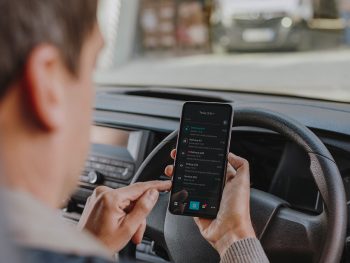How can the latest onboard fleet monitoring technology help businesses improve efficiency and cut costs? Matt MacConnell finds out.

With company margins squeezed by the rising inflation over the past couple of years, things are no longer as simple as a job getting done on time. Fleet managers are now looking to contain costs and find affordable solutions to assist in monitoring their large or small fleets. Over recent years, advances in telematics have enabled fleet managers to drill down into van-related information such as speed, driver efficiency and costs saved. This not only allows fleets to save cash, but also allows managers to concentrate on driver training and other vital areas.
Edinburgh-based software company, Podfather, says that the adoption of telematics and similar systems has never been easier for LCV operators.
“It is increasingly important for a delivery business to look beyond telematics, as it needs fleet management tools that address its specific KPIs,” explains Jane Geary, Podfather marketing director. “There has never been more choice, meaning a van operator can pick and choose the features and functionality that are tailored to their requirements. While some companies do want all the sophistication that a full telematics system can provide, others have different objectives. They might want routing and scheduling capability to reduce pence-per-mile delivery costs, but only want the track and trace functionality of telematics, for example.”
For electric van fleets, Podfather allows users to identify fleet EVs and enter van-specific range information to ensure that route planning is as accurate as possible.
“Analysis of our customer base shows that only around 10% are using Podfather’s EV capabilities,” says Geary. “They are mainly focused on food deliveries, so multi-drop operations in urban areas where an EV’s range is more than sufficient. It’s no different to platforms for diesel vans in that operators don’t want to pay for functionality that they don’t need. Some fleets will use, and benefit, from more complex systems, but many more will not want to pay for what they perceive as bells and whistles.”
Many fleet managers may be pondering over the change to EV, which can lead to further questions. Various factors such as load, battery size, temperature and driver awareness can affect a van’s range. According to Webfleet, the latest figures reveal a 16% year-on-year rise in electric van registrations, driven mostly by their burgeoning capabilities. In recent months, a big innovation example would be the emergence of route optimisation, which is designed to help maximise van fleet productivity and minimise downtime.
“Route optimisation follows an array of dedicated software tools to help make running an electric LCV fleet more efficient, including energy consumption reports that detail energy usage in kWh, per vehicle, per day, and charger connection insight reports,” says Beverley Wise, Webfleet regional director. They all ensure charging takes place at the times of day when tariffs are most favourable and just before vehicles are needed for operation. Elsewhere, amidst considerable economic volatility and new and emerging business models, telematic solutions are addressing van fleet demands for operational flexibility.”
App’s the way to do it

Webfleet’s Work app was launched in direct response to this need – and it has enabled van drivers to access the Webfleet platform with an Android device. This means swift onboarding and no hardware installation, minimising downtime and allowing focus on further work. Fleets can set up short-term contracts and, when personnel change, existing subscriptions can be reused either for new vehicles or drivers. Wise adds: “Today, more than ever, necessity has become the mother of invention when it comes to fleet management technology. Practical solutions are being developed apace to help van operators meet the challenges of what is one of the most transformative transport environments the sector has ever seen.”
With electric vans gaining prominence, some fleet managers may query how added technology affects the van’s range. According to Targa Telematics, telematics systems do not drain EV batteries — instead, they enhance longevity and efficiency. In fact, OEM equipment data plays a crucial role in the LCV market. For vehicles devoid of in-built sensors, Targa Telematics bridges the connectivity gap by incorporating its own devices and has developed increasingly innovative solutions by working with large vehicle manufacturers, which means that its telematics can be used with an array of vehicle makes and models. This allows fleet managers to review OEM vehicle data easily, for example warning lights, odometer readings and service countdowns, meaning less downtime.
High-value loads
For fleets that transport high-value goods, such as electronics, pharmaceutical shipments and more, there are various van tracking systems available. “Asset trackers need to be as small and inconspicuous as possible, with some now designed to be disguised as part of the cargo or load and easily concealed from prying eyes,” says Vernon Bonser, UK sales director, Queclink. “However, any solution still needs to be robust and dependable, so devices should be ruggedised and waterproof to handle changing conditions. Battery management is paramount, so the ability to intelligently manage reporting intervals depending on device status will not only maintain but extend battery life. Leading manufacturers are offering options such as rechargeable and re-usable devices that lend themselves to a wider range of use cases, making asset tracking more efficient and affordable.”
Depending on the fleet’s needs, various options such as ‘remote-and-hardware’ trigger options are a must, allowing fleet managers to set alerts based on location, tamper and more. More premium products offer direct connectivity to sensors, which allows light, heat and moisture to be monitored. Fleet telematics company Tracker says that companies need data for in-transit shipments to improve operations, reduce risk and resolve issues. For cold chain logistics, telematics can help maintain temperatures, which are vital, as fluctuations can cause spoilage or degradation of goods.
“For high-value loads, it is now possible to monitor any route deviation or if doors have been opened outside permitted areas, so fleets can be instantly alerted to a potential security risk,” comments Inseego managing director Steve Thomas. “Fleets can also take advantage of remote panic alarms, which are connected wirelessly to the telematics system. They typical have a range of 30-40 metres, which allows the driver to raise an alarm whether they are inside or outside the vehicle.”
According to SureCam, besides driver training, tracker systems and other telematics hardware or software, video telematics are just as important. Sam Footer, the company’s partnership director, says: “One major development for van fleets is the combination of video telematics with lone worker technology to provide drivers with a quick and easy way to request assistance. Organisations are increasingly focusing on employee safety as part of mitigating fleet risk, so video-enabled driver protection is an effective way of safeguarding them both in and outside the vehicle. This offers high levels of peace of mind to the people who drive for a living, and their employers, by taking lone worker safety to the next level and adding an extra layer of protection to what is currently available using traditional vehicle tracking or a video telematics solution.”


